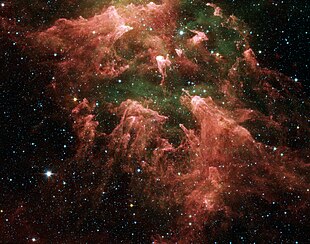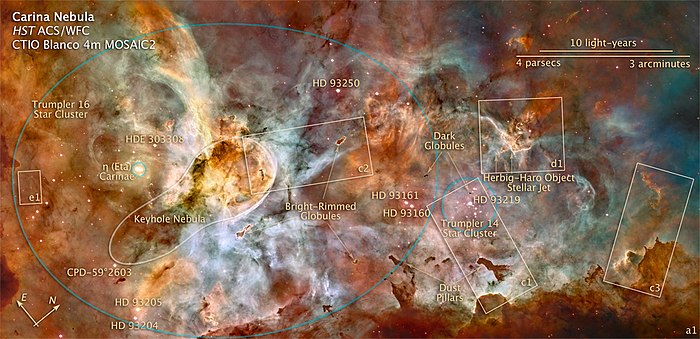Carina Nebula
| Emission nebula | |
|---|---|
| Carina Nebula Eta Carinae Nebula
|
|

|
|
| The entire Carina Nebula in infrared light , image taken by the Spitzer Space Telescope | |
| AladinLite | |
| Constellation | Keel of the ship |
|
Position equinox : J2000.0 , epoch : J2000.0 |
|
| Right ascension | 10 h 45 m 09 s |
| declination | -59 ° 52 ′ 04 ″ |
| Appearance
|
|
| Apparent brightness (B-band) | 3.0 likes |
| Angular expansion | 120 minutes of arc |
| Ionizing source | |
| Physical data
|
|
| distance | 6500-10000 Lj |
| diameter | 200-300 ly |
|
history
|
|
| discovery | Nicolas Lacaille |
| Date of discovery | 1751 |
| Catalog names | |
| NGC 3372 • ESO 128-EN13 • Dunlop 309, Lacaille III.6 | |
The Carina Nebula ( NGC 3372 ), also known as the Eta Carinae Nebula , is an emission nebula in the constellation of the ship's Kiel . It has an apparent magnitude of 3.0 mag and a diameter of 120 arc minutes . The nebula is one of the largest HII regions in the galaxy and is approximately 6,500 to 10,000 light years from Earth. So it extends over about 200-300 light years.
The best-known single object in the Carina Nebula is the variable star η (Eta) Carinae , which is part of the Trumpler 16 open cluster .
discovery
Although the nebula is one of the brightest objects in the night sky - it is significantly larger and also brighter than the Orion Nebula - it was documented relatively late because of its extremely southern location. It was not until 1751–1752 that Nicolas Louis de Lacaille described him on his trip to the Cape of Good Hope . He recorded the nebula as Lacaille III.6.
Astronomical meaning
This nebula complex lies in the Sagittarius arm of the Milky Way . As one of its largest H-II regions , the Carina Nebula represents a large star formation region , similar to the Orion Nebula. Therefore, it contains various open star clusters, including the clusters Collinder 228 , 232 and 234 , Trumpler 14 , 15 and 16 and Bochum 10 and 11 .
The nebula contains several stars of the spectral class O, including the first discovered stars of the O3 type. In addition, three Wolf-Rayet stars of the WN class have been found so far .
Objects in the Carina Nebula

- Trumpler 14 : a young open star cluster with the hypergiant HD 93129A
- Trumpler 16 : an open star cluster, the most prominent member of which is η-Carinae
- Keyhole Nebula: It is a dark fragment of the Carina Nebula, which stands out in the center against lighter regions in the background in the shape of a keyhole.
- Homunculus Nebula : It is a bipolar ejection of matter from η-Carinae in the form of two opposing spheres that surround the star. The Homunculus Nebula is the remnant of a stellar outbreak that made the star the second brightest star in the night sky in the 1840s.
- Horseshoe Nebula (not to be confused with the sometimes similarly named Omega Nebula ): It is a horseshoe-shaped ring made of material that comes from an older material ejection Eta Carinas. The nebula is about 2 light years in size.
See also
Web links
- SEDS entry via NGC 3372
- "Hubble Heritage Release": Panoramic image of the nebula through the Hubble Telescope, released April 24, 2007
- Virtual tour at Hubblesite.org ( Adobe Flash )
- An Atlas of The Universe: NGC 3372 - The Eta Carinae Nebula
- ESO: Cool Clouds in the Carina Nebula + Photos, Map & Animations - November 16, 2011
- ESO: Pillars of Destruction + Photos & Animations - November 2nd, 2016
- ESO: Stars and dust competing in the Carina Nebula + photos, map & animations - August 29, 2018
- Spektrum.de : Collection of amateur recordings


